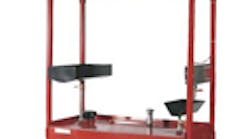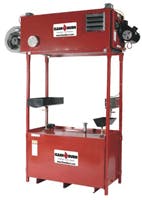New hydraulic oil is clean and clear, but when you look at it after it’s run through a system hundreds of times, the oil may look dirty, milky, or even black. Is this used hydraulic fluid of any value, or will it end up racking up substantial disposal costs?
More and more users of hydraulic fluid are burning it to make energy rather than having to dispose of it, says Michael Shirk, president and CEO of Clean Burn, Leola, Pa. The company makes furnaces and boilers that transform used oil generated by heavy equipment and vehicles into heat. Rather than haul away used oil and risk environmental spills and contamination of the earth, owners of EPA-approved Clean Burn units are gaining free heat while making a positive environmental impact.
“Within a very short time, the investment in a Clean Burn used-oil heating system pays back more handsomely than any other alternative available,” says Shirk. “Whether you’re a farmer maintaining a fleet of equipment or a repair shop, the return-on-investment with these units is amazing. They eliminate the liability and costs of taking used oil off-site for disposal while also lowering heating costs and saving energy.”
With a Clean Burn system, used oils are recycled through a furnace or burner. The resulting energy can be channeled to provide heat to a specific location, such as baseboard heating in a shop or other uses.
Used oil possesses nearly twice the energy value of coal and more energy than other fuel oils. One gallon of used oil can generate 18 kWh of electricity.
If a Clean Burn user burns about 1500 gal of used oil a year, he or she might save $3750 on fuel bills.
The wide variety of industries saving on energy costs by using Clean Burn systems include farms and agri-businesses, exc ava t ion and mining companies, recycling and salvage facilities, construction companies, and fleet operation centers.
The company manufactures a variety of furnaces for a wide variety of plants that use hydraulic fluids or with large fleets of mobile equipment. Models include the Compact Used Oil furnace, Low Profile Used Oil furnace, and Large Volume Used Oil furnace. In addition, a Used Oil Recycling center works with furnaces and is a self-contained, on-site recyling and heating system that allows businesses to store and burn used oil.
For information, call (800) 331- 0183 or visit www.cleanburn.com.


